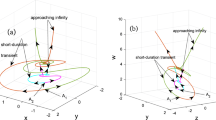Abstract
Very little research is available in the field of sub-quadratic chaotic systems. This note reports a new 3D sub-quadratic Lorenz-like system: \({\dot{x}}=a(y - x)\), \({\dot{y}}=c\root 3 \of {x} - \root 3 \of {x}z\), \({\dot{z}}= -bz + \root 3 \of {x}y\). Except for the rich dynamics, i.e., generic and degenerate pitchfork bifurcation, first integral, invariant algebraic surface, ultimate bounded set, singularly degenerate heteroclinic cycle with nearby chaotic attractor, and existence of a pair of heteroclinic orbits, etc., this proposed system gives birth to Lorenz-like chaotic attractors coexisting the unstable origin and two stable node-foci in a broad range of the parameter c and thus hidden attractors are coined, which verifies the guess that the decrease of powers of some variable states may widen the ranges of some parameters for which hidden attractors exist. This may not only provide a new method to detect hidden Lorenz-like attractors, but also pose an interesting problem that the existence of hidden attractors can be determined by the degrees of the variables of the studied systems.






Similar content being viewed by others
Data Availability
This manuscript has no associated data or the data will not be deposited. [Authors’ comment: This is a theoretical study or no experimental data has been listed.]
References
G.A. Leonov, N.V. Kuznetsov, T.N. Mokaev, Homoclinic orbits, and self-excited and hidden attractors in a Lorenz-like system describing convective fluid motion. Eur. Phys. J. Spec. Top. 224, 1421–1458 (2015)
X. Zhang, G. Chen, Constructing an autonomous system with infinitely many chaotic attractors. Chaos Interdiscip. J. Nonlinear Sci. 27(7), 071101-1–5 (2017)
N.V. Kuznetsov, G.A. Leonov, T.N. Mokaev, A. Prasad, M.D. Shrimali, Finite-time Lyapunov dimension and hidden attractor of the Rabinovich system. Nonlinear Dyn. 92, 267–285 (2018)
D. Hilbert, Mathematical problems. Bull. Am. Math. Soc. 8, 437–479 (1902)
N.V. Kuznetsov, T.N. Mokaev, O.A. Kuznetsova, E.V. Kudryashova, The Lorenz system: hidden boundary of practical stability and the Lyapunov dimension. Nonlinear Dyn. 102, 713–732 (2020)
X. Li, H. Wang, A three-dimensional nonlinear system with a single heteroclinic trajectory. J. Appl. Anal. Comput. 10(1), 249–266 (2020)
Y. Liu, Q. Yang, Dynamics of a new Lorenz-like chaotic system. Nonl. Anal RWA 11(4), 2563–2572 (2010)
H. Wang, X. Li, On singular orbits and a given conjecture for a 3D Lorenz-like system. Nonlinear Dyn. 80(1), 969–981 (2015)
T. Li, G. Chen, G. Chen, On homoclinic and heteroclinic orbits of the Chen’s system. Int. J. Bifurcat. Chaos 16(10), 3035–3041 (2006)
G. Tigan, D. Constantinescu, Heteroclinic orbits in the \(\mathit{T}\) and the Lü system. Chaos Solit. Fract. 42(1), 20–23 (2009)
H. Wang, C. Li, X. Li, New heteroclinic orbits coined. Int. J. Bifurcat. Chaos 26(12), 13 (2016). (Article No. 1650194)
G. Tigan, J. Llibre, Heteroclinic, homoclinic and closed orbits in the Chen system. Int. J. Bifurcat. Chaos 26(4), 6 (2016). (Art. no. 1650072)
H. Wang, X. Li, Infinitely many heteroclinic orbits of a complex Lorenz system. Int. J. Bifurcat. Chaos 27(7), 14 (2017). (Art. no. 1750110)
H. Wang, X. Li, A novel hyperchaotic system with infinitely many heteroclinic orbits coined. Chaos Solit. Fract. 106, 5–15 (2018)
H. Wang, F. Zhang, Bifurcations, ultimate boundedness and singular orbits in a unified hyperchaotic Lorenz-type system. Discr. Contin. Dyn. Syst. Ser. B 25(5), 1791–1820 (2020)
Acknowledgements
This work is supported in part National Natural Science Foundation of China under Grant 12001489, in part Zhejiang Public Welfare Technology Application Research Project of China(Grant: LGN21F020003), in part Natural Science Foundation of Taizhou University (Grant: T20210906033), in part NSF of Zhejiang Province under Grant LY20A020001, LQ18A010001, in part NSF of Zhejiang University of Science and Technology under Grant F702108J03 and Grant F701108G13. At the same time, the authors wish to express their sincere thanks to the anonymous editors and reviewers for their conscientious reading and numerous valuable comments which extremely improve the presentation of the paper.
Author information
Authors and Affiliations
Corresponding author
Ethics declarations
Conflict of interest
The authors declare that there is no conflict of interest in the manuscript.
CRediT authorship contribution statement
HW: conceptualization, software, writing-original draft, visualization, investigation. GK: supervision, software, methodology, investigation, visualization. JP: writing-original draft. FH: writing-review and editing. HF: writing-review and editing.
Rights and permissions
About this article
Cite this article
Wang, H., Ke, G., Pan, J. et al. Multitudinous potential hidden Lorenz-like attractors coined. Eur. Phys. J. Spec. Top. 231, 359–368 (2022). https://doi.org/10.1140/epjs/s11734-021-00423-3
Received:
Accepted:
Published:
Issue Date:
DOI: https://doi.org/10.1140/epjs/s11734-021-00423-3




